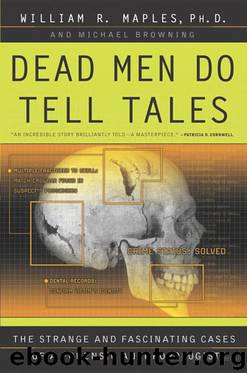Dead Men Do Tell Tales: The Strange and Fascinating Cases of a Forensic Anthropologist by Maples William R

Author:Maples, William R. [Maples, William R.]
Language: eng
Format: epub
ISBN: 9780307763907
Amazon: B004089HZW
Publisher: Random House, Inc.
Published: 2010-09-01T04:00:00+00:00
11
Death in 10,000 Fragments
You will say that reality does not have the slightest obligation to be interesting. I reply that even if reality can escape the necessity of being interesting, hypotheses never can.
—Jorge Luis Borges, Death and the Compass
There is a stretch of I–75 about twenty miles north of Gainesville along which the great highway passes through a green and smiling landscape, all rolling fields and thick forests of pine and live oak. I can never travel this particular portion of the interstate without glancing over at a beautiful pasture that appears just south of the exit for High Springs, via County Road 236. This pasture has a solitary oak tree at its edge, then a dense stand of forest just to the west.
Sheltered under the eaves of this forest are the ruins of an old burned shack. Within those charred ruins, on January 28, 1985, were found the remains of two calcined human skeletons, so badly burned that they were almost reduced to powder. Next to one of the skeletons, welded shut by the fury of the fire that consumed the shack and its occupants, was an Ithaca Model 37 12-gauge shotgun whose stock had been completely reduced to ashes.
Today when anyone asks me which was the most difficult, the most fascinating and perplexing case I have ever encountered, I answer without an instant’s hesitation: the Meek-Jennings case. I have examined human remains, ancient and modern, famous and obscure, in Asia, Africa, Europe and South America, as well as all over the United States; but I had only to travel twenty miles from my front doorstep to encounter the most baffling and complex problem in forensic anthropology that has ever occupied my mind or challenged the resources of the C. A. Pound Human Identification Laboratory.
The Meek-Jennings case began with a hellish fire, and from the first moment it was possessed of a hellish complexity. That fire, and those skeletons, would occupy me and my students for the next year and a half. Many times during my inquiry a vital piece of evidence would dangle just out of reach, then, when grasped, would slip away or reverse its meaning. I had to unravel a set of remains that occupied only a few square feet, but whose tangled history reached from Alaska to Florida, across thousands of miles and a dozen years.
Everything about this case seemed to defy a simple solution. Things seemed to reduplicate themselves, multiply themselves, fragment themselves. At times we seemed to be gazing through a kaleidoscope instead of a magnifying glass.
At first we thought we were dealing with one fire; it turned out there were two. We imagined we were investigating two deaths; later we found out there were four. The deaths occurred in pairs, in two states, widely separated. There were two suicide notes, both of which looked fake. There were dozens and dozens of antemortem and postmortem x-rays to compare, some of them of very poor quality. Other x-rays, which would have solved the case in an instant, had been destroyed.
Download
This site does not store any files on its server. We only index and link to content provided by other sites. Please contact the content providers to delete copyright contents if any and email us, we'll remove relevant links or contents immediately.
Periodization Training for Sports by Tudor Bompa(8171)
Why We Sleep: Unlocking the Power of Sleep and Dreams by Matthew Walker(6618)
Paper Towns by Green John(5092)
The Immortal Life of Henrietta Lacks by Rebecca Skloot(4526)
The Sports Rules Book by Human Kinetics(4296)
Dynamic Alignment Through Imagery by Eric Franklin(4118)
ACSM's Complete Guide to Fitness & Health by ACSM(3989)
Kaplan MCAT Organic Chemistry Review: Created for MCAT 2015 (Kaplan Test Prep) by Kaplan(3940)
Introduction to Kinesiology by Shirl J. Hoffman(3726)
Livewired by David Eagleman(3685)
The Death of the Heart by Elizabeth Bowen(3553)
The River of Consciousness by Oliver Sacks(3542)
Alchemy and Alchemists by C. J. S. Thompson(3451)
Bad Pharma by Ben Goldacre(3357)
Descartes' Error by Antonio Damasio(3231)
The Emperor of All Maladies: A Biography of Cancer by Siddhartha Mukherjee(3068)
The Gene: An Intimate History by Siddhartha Mukherjee(3049)
The Fate of Rome: Climate, Disease, and the End of an Empire (The Princeton History of the Ancient World) by Kyle Harper(3006)
Kaplan MCAT Behavioral Sciences Review: Created for MCAT 2015 (Kaplan Test Prep) by Kaplan(2941)
